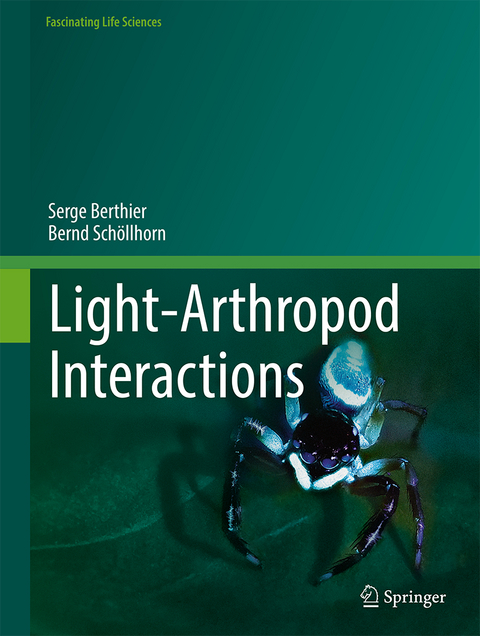
Light-Arthropod Interactions
Springer International Publishing (Verlag)
978-3-031-76223-9 (ISBN)
- Noch nicht erschienen - erscheint am 27.03.2025
- Versandkostenfrei
- Auch auf Rechnung
- Artikel merken
Terrestrial arthropods (insects, spiders, etc.) dominate the world in numbers and extreme diversity. This book presents the combined views of a physicist, a chemist, and a biologist on the fascinating interactions of these organisms with the primary source of energy on Earth, light. It describes the plethora of important phenomena observed in different spectral ranges, from ultraviolet to visible to mid-infrared. These phenomena, often unprecedented, occur at all scales - macroscopic, microscopic, and nanoscopic. They are richly illustrated with original and aesthetic high-quality images. The descriptions and explanations are comprehensive for researchers and students as well as entomologists and, in general, accessible to anyone fascinated by the beauty and complexity of nature. More detailed explanations are presented in appendices for ease of reading. They may be omitted without affecting the general understanding of the main text. Researchers and engineers will also find numerous avenues for bioinspired developments in various fields such as energy, environment, agriculture, and ecology.
Serge Berthier
Born in Paris in 1952, he first conducted theoretical and applied research on selective materials for the thermal conversion of solar energy. After his PhD, he first became a professor at the Université Pascal Paoli, Corte (France) where he spent 7 years, between 1981 and 1987. In 1987 he moved to Paris Cité, where he is an invited professor at the Namur University, Belgium, and is currently a senior fellow of the UNESCO-UNISA chair in Nanoscience and Nanotechnology in Cape Town (South Africa).
Since 2003, he has focused on the study, characterization, and modeling of natural photonic structures, such as those found in butterfly wing scales, coleopteran elytra, bird feathers, and diatoms. These structures have been considered as models for bio-inspired devices, including solar absorbers, molecular detectors, anti-counterfeiting devices for banknotes, cosmetic pigments, and LEDs. Together with Prof. Schöllhorn, he is currently focusing his research on natural fluorescence and bioluminescence.
Bernd Schöllhorn
After receiving his PhD in Organic Chemistry from Freie Universität Berlin, Bernd Schöllhorn held two research fellowships at the University of California (San Diego) and the Université René Descartes (Paris). Since 1995, he has been an Associate Professor at the Université Blaise Pascal (Clermont-Ferrand) and the Ecole Normale Supérieure, Paris, and was appointed full professor at the Université Paris Cité in 2009. His research interests ranged from natural product synthesis and biomimetic catalysis to the electrochemistry of supramolecular assemblies on the nanoscale. As a passionate hiker and nature lover, he has always been fascinated by arthropods. In recent years, he has therefore begun to focus his scientific research on the physico-chemical phenomena of living organisms, consciously pursuing a transdisciplinary approach. Together with Prof. Berthier, he focuses on the photoluminescence properties of biomaterials.
Part 1: General.- Light, waves, photons.- Simplified phylogeny of arthropods. Focus on insects.- Characteristics of living structures: Multifunctionality, economy, disorder and complexity.- Vision, colorimetry, role of colours in the living world (influence of insect behaviour and survival: communication, social interactions, attraction, predation, camouflage, mimicry).- Impact of light on living organisms: development/evolution, radiation protection (UV, blue), uptake of metabolites, pollination of flowers).- Why are insects attracted to light? Light pollution (effects on insects, applications and threats).- Part two: The Visible.- Introduction: Origin of colours (pigments, structures, emission).- Pigments.- Physical colours.- Mixed systems.- Transparency. Why, how.- Bioluminescence (Fireflies, wireworms, etc.).- Part three: The Ultraviolet.- Reflection and diffusion of UV, interaction flowers-insects.- Fluorescence / Phosphorescence: Principle.- Insects: fluorescent biomaterials and metabolites.- Other arthropods: Chelicerata, Myriapoda.- Oriented emission, guidance.- Part Four: The Infrared.- Insect thermoregulation: principles.- Solar infrared: absorption - Thermal infrared: Emission.- Fluorescence.- Part five: Characterization and modelling techniques.- Physical characterizations.- Chemical characterizations.- Modelling: Finite elements, RCWA, FDTD.- Part Six: Bio-inspiration.
| Erscheint lt. Verlag | 27.3.2025 |
|---|---|
| Reihe/Serie | Fascinating Life Sciences |
| Zusatzinfo | Approx. 350 p. 450 illus., 250 illus. in color. |
| Verlagsort | Cham |
| Sprache | englisch |
| Maße | 210 x 279 mm |
| Themenwelt | Naturwissenschaften ► Biologie ► Zoologie |
| Schlagworte | Bio-inspiration • Bioluminescence • diffraction • Entomology • insect colors • Interference • nanostructures • optical properties • Optics • photoluminescence • Photonic structures • Pigments • Transparency |
| ISBN-10 | 3-031-76223-1 / 3031762231 |
| ISBN-13 | 978-3-031-76223-9 / 9783031762239 |
| Zustand | Neuware |
| Haben Sie eine Frage zum Produkt? |
aus dem Bereich


